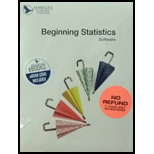
To find:
The difference between the more precise value found using the
Also the similar difference for the area within three standard deviations of the mean.
Answer to Problem 21E
Solution:
The difference of area under the standard normal curve between the precise calculation and Empirical Rule within two standard deviations is
Explanation of Solution
Given:
The
In statistics, the normal
where,
The normal Gaussian distribution with the following characteristics:
is called standard normal distribution with probability density function:
When this function is plotted on the
Area on the left of given
The
The area beyond two
The Empirical Rule, also known as the
Calculation:
First, consider
Next, consider
The required probabilities are the differences of the probabilities to the left of
The
The area under standard normal curve beyond the
This is the precise probability as found using standard normal table.
The Empirical Rule states that between
The difference is as:
which can be changed into the percent as:
On the other hand, the
The area under standard normal curve beyond the
This is the precise probability as found using standard normal table.
The Empirical Rule states that between
The difference is as:
which can be changed into the percent as:
Conclusion:
The difference of area under the standard normal curve between the precise calculation and Empirical Rule within two standard deviations is
Want to see more full solutions like this?
Chapter 6 Solutions
BEGINNING STATISTICS-CD (NEW ONLY)
 MATLAB: An Introduction with ApplicationsStatisticsISBN:9781119256830Author:Amos GilatPublisher:John Wiley & Sons Inc
MATLAB: An Introduction with ApplicationsStatisticsISBN:9781119256830Author:Amos GilatPublisher:John Wiley & Sons Inc Probability and Statistics for Engineering and th...StatisticsISBN:9781305251809Author:Jay L. DevorePublisher:Cengage Learning
Probability and Statistics for Engineering and th...StatisticsISBN:9781305251809Author:Jay L. DevorePublisher:Cengage Learning Statistics for The Behavioral Sciences (MindTap C...StatisticsISBN:9781305504912Author:Frederick J Gravetter, Larry B. WallnauPublisher:Cengage Learning
Statistics for The Behavioral Sciences (MindTap C...StatisticsISBN:9781305504912Author:Frederick J Gravetter, Larry B. WallnauPublisher:Cengage Learning Elementary Statistics: Picturing the World (7th E...StatisticsISBN:9780134683416Author:Ron Larson, Betsy FarberPublisher:PEARSON
Elementary Statistics: Picturing the World (7th E...StatisticsISBN:9780134683416Author:Ron Larson, Betsy FarberPublisher:PEARSON The Basic Practice of StatisticsStatisticsISBN:9781319042578Author:David S. Moore, William I. Notz, Michael A. FlignerPublisher:W. H. Freeman
The Basic Practice of StatisticsStatisticsISBN:9781319042578Author:David S. Moore, William I. Notz, Michael A. FlignerPublisher:W. H. Freeman Introduction to the Practice of StatisticsStatisticsISBN:9781319013387Author:David S. Moore, George P. McCabe, Bruce A. CraigPublisher:W. H. Freeman
Introduction to the Practice of StatisticsStatisticsISBN:9781319013387Author:David S. Moore, George P. McCabe, Bruce A. CraigPublisher:W. H. Freeman





